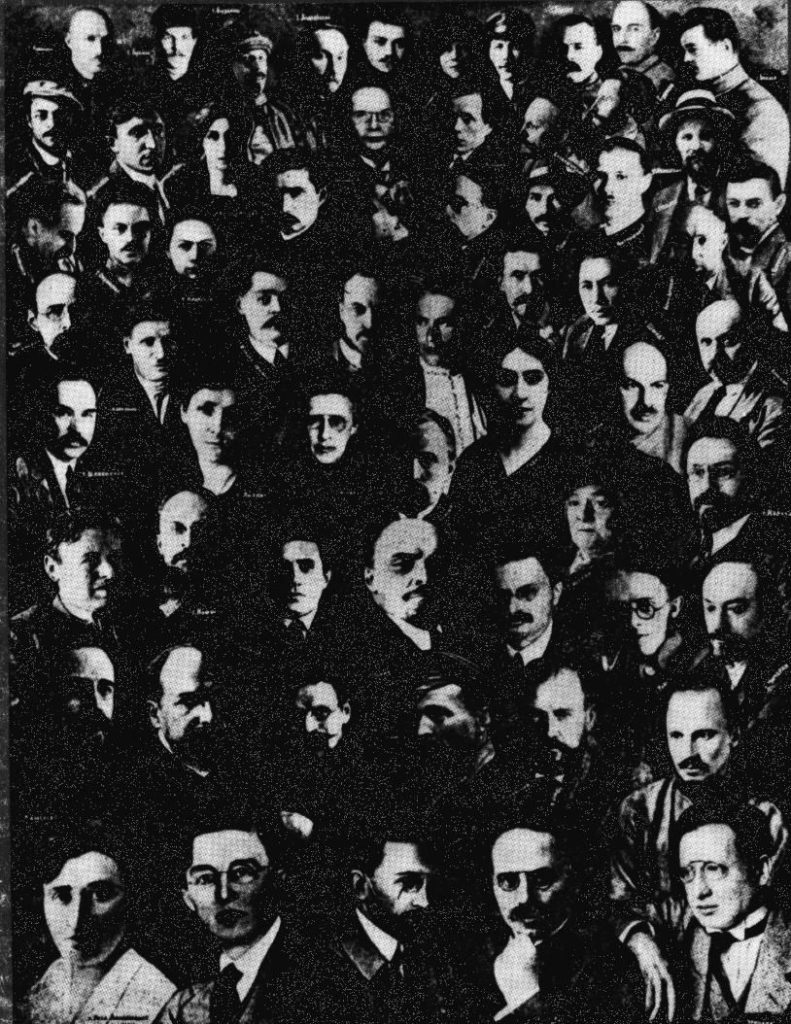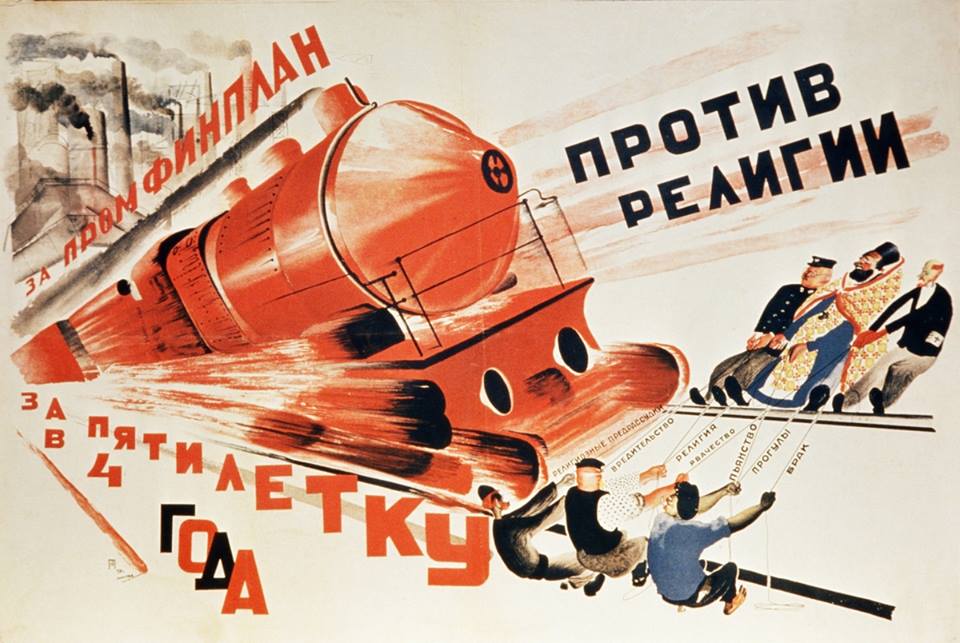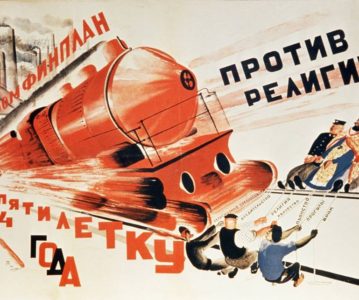J.R. Murray argues that the left must abandon the micro-sect form of organization derived from a false reading of the true meaning of Bolshevism, or else we will continue to exist in an endless cycle of self-marginalization.

It was only 28 years ago that liberal democracy triumphed and the fall of the USSR ushered in “The End of History”. In subsequent decades the U.S. working class was subjected to a neoliberal onslaught which dismantled an already weak welfare state and eroded worker power. But today, after the 2008 financial crisis, the ensuing global recession, the Occupy protests, a specious economic recovery, the overall stagnation and disillusionment of the Obama years, and the rise of Donald Trump, liberal democracy is threatened to a degree that would have felt unimaginable in 1991.
The American bourgeoisie has no solution for continued economic and social inequality, climate catastrophe, or the alienation of everyday life. The logic of capitalism compels the ruling class to roll back every concession the working class gained since the New Deal. The same tunnel vision is on display in the militarization of the southern border, mass deportation, and stoking of nationalism and xenophobia. In a way, this is just practice for the coming mass migrations spurred on by ecological collapse. The United States is rapidly becoming a police state for its poorest inhabitants, who suffer the worst deprivations of capitalism and the climate catastrophe it has unleashed while having their political rights eviscerated, their lives meticulously surveilled, and their movements constricted. For most people the present is unsustainable and the future is bleak. The working class, especially young workers, are looking for an alternative, and socialism’s appeal is re-emerging. One result of this re-emergence has been the explosive growth of the Democratic Socialists of America (DSA) and the modest growth of “Leninist” socialist organizations such as Socialist Alternative (SAlt), the Party for Socialism and Liberation (PSL), and the International Socialist Organization (ISO), before its dissolution earlier this year.
Since Donald Trump’s election, the DSA’s popularity has risen above and beyond what their Leninist cousins could ever hope to achieve. While the DSA suffers from serious problems, it still offers hope for a renewed socialist movement. On the other hand, the Leninist sect exemplifies an outdated organizational structure that featured so prominently in the failures of 20th-century socialism. Indeed, just recently the ISO voted to dissolve itself in part due to scandals and abuses that tend to flourish in the top-down sect structure. Critical analysis of the Leninist sect and its failures was necessary before the ISO collapsed and is even more necessary while we sift through the debris.
To understand the structural failures of the sect and the poor strategy this structure engenders we need to locate the key historical assumptions that are routinely invoked as a justification for incompetent political and organizational positions. This is an imperative first step if we wish to move beyond ineffectual sects and toward a radically democratic mass party as the vehicle for the working-class seizure of power.
Lenin & Today’s Bolsheviks
Socialist organizations across the ideological spectrum justify a myriad of positions by invoking Lenin and the Bolshevik party. But which Lenin are they praising? The Lenin of 1905 who believed the Russian Revolution would be a bourgeois revolution, or the Lenin who wrote the April Theses? The Lenin that helped to ban factions within the party or the Lenin who, at the end of his life, warned his comrades of the rising bureaucracy? Lenin the living, breathing, man, or Lenin the body, mummified and forced to lie in a mausoleum against his wishes? Lenin is no deity. He invokes inspiration because of his courage, dynamic range of thought, brilliant timing, and careful use of Marxist analysis. But today, a self-perpetuating bureaucracy sifts through Lenin’s work, interpreting it for their own ends, cutting and pasting pieces of it to justify their existence.
The leading “revolutionary” socialist parties fashion themselves after the Bolsheviks of 1917. But their conception of the Bolshevik party is like their conception of Lenin: flat and ossified. In reality, nearly every self described “Leninist” organization today is descended from the post-1921 Bolshevik party — a bureaucratic, top-down apparatus disconnected from the people it claimed to represent.
In 1921 the Bolsheviks were in a desperate situation, floundering after the failure of revolution in industrialized Europe and reeling from the one-two punch of World War I and their own brutal civil war which left their economy destroyed. Worst of all, members of the Russian working class were either dead, demoralized, or fleeing to the countryside. At the start of the 20th century, Russia was a nation of peasants just beginning to take steps toward industrialization, and by 1921 they had taken steps backward; if the working class was small before the wars, now it barely existed. In his massive biography of Trotsky, Isaac Deutscher summarized the situation:
Thus a few years after the revolution the nation was incapable of managing its own affairs and of asserting itself through its own authentic representatives. The old ruling classes were crushed; and the new ruling class, the proletariat, was only a shadow of its former self. No party could claim to represent the dispersed working class; and the workers could not control the party which claimed to speak for them and to rule the country on their behalf.
Whom then did the Bolshevik party represent? It represented only itself, that is, its past association with the working class, its present aspiration to act as guardian of the proletarian class interest, and its intention to reassemble in the course of economic reconstruction a new working class which should be able in due time to take the country’s destinies into its hands. In the meantime, the Bolshevik party maintained itself in power by usurpation. Not only its enemies saw it as a usurper—the party appeared as a usurper even in the light of its own standards and its own conception of the revolutionary state.
The Bolsheviks of 1921 existed to perpetuate their own existence as regents of the absent working class. Almost 100 years later, revolutionary socialist organizations cannot offer the same excuse. There is no reason for U.S. socialist organizations to copy emergency structural reforms put into place by the Bolshevik party in the early Soviet Union. An enormous working-class suffering indignity and exploitation surrounds the U.S. Left and yet barely comes into contact with it. These socialist parties hang suspended in mid-air, gazing down at the working class below, never close enough to meet it for more than a moment.

Bureaucratic Centralism
Just as socialist parties remain separated from the working class, the leadership of socialist parties stays separated from their rank-and-file members. Assuming they toe the party line, certain individual activists are allowed into the leadership circle. But the leadership itself remains small and powerful. Decisions are often made without consulting the rank-and-file, and bureaucratic maneuvering dominates the politics of decision making. The ruling clique controls the party from the top down, enforcing its ideological program and ensuring a constant stream of new recruits to replace previous burnt out cadre.
Hal Draper would describe the current Leninist parties as “bureaucratic sects”. He explained the basic strategy of these sects in his pamphlet “Anatomy of a Microsect”:
The sect mentality typically sees the road ahead as one in which the sect (one’s own sect) will grow and grow, because it has the Correct Political Program, until it becomes a large sect, then a still larger sect, eventually a small mass party, then larger, etc., until it becomes large and massy enough to impose itself as the party of the working class in fact. But in two hundred years of socialist history, this has never actually happened, in spite of innumerable attempts.
The sect wishes to recruit members in the ones and twos with the hopes that, one day, it will be large enough to superimpose itself onto a working class movement.
Because of its relation to the proletariat as the perennial other, a sect may be completely unaware of the working class’s needs, concerns, and demands. Draper elaborates that the sect instead “counter-poses its sect criterion of programmatic points against the real movement of the workers in the class struggle, which may not measure up to its high demands.” Rather than expressing the will of the working class, a sect demands that the working class bend to its will.
Draper described the bureaucracy’s strategy in a sentence, “…their organizational road to power is the formation of an elite band of Maximum Leaders which holds itself ready to bestow its own rule, at a propitious movement, on an elemental upsurge of the people.” For a sect, the party is not a vehicle of working class power and a means for workers to emancipate themselves; instead, the working class is a wave upon which the party rides into power.
Within the modern sect, intra-party democracy is suppressed and, as always, Lenin and the Bolsheviks are invoked as justification. The defenders of the sect-form claim to practice the same democratic centralism as the 1917 Bolsheviks, but their stunted understanding of the party structure that helped make the Bolsheviks’ successful in 1917 prevents them from recognizing their actual organizational forebearers: the post-civil war Bolshevik party.
By 1921 opposition parties were effectively banned. By many accounts this was not an ideal which the Bolsheviks worked to achieve, but rather a reality forced on them through dire circumstance. Deutscher shares an anecdote by the Menshevik Sukhanov which highlights this point:
Sukhanov relates that three years later after the Bolsheviks had banned all the parties of the opposition, he reminded Trotsky of his pledge not to lend himself to the suppression of any minority. Trotsky lapsed into silence, reflected for a while, and then said wistfully: “Those were good days.”
Deutscher’s description of the internal debates leading up to institutionalized one-party rule reinforces how important internal democracy was to early Bolshevism. He depicts the party at a crossroads where “…Bolshevism suffered a moral agony the like of which is hardly to be found in the history of less intense and impassioned movements. Later Lenin recalled the ‘fever’ and ‘mortal illness’ which consumed the party in the winter of 1920-21.” The Bolsheviks had intended one-party rule to be temporary, possibly lasting several years, possibly a couple of decades, but never lasting forever. The logic of banning opposition in the Soviets inevitably led to the banning of factions within the party itself, deepening an anti-democratic trend and setting the stage for Stalinist bureaucracy to flourish.
The socialist parties of today are direct descendants of that bureaucratic party-form, and they have fewer qualms than their Bolshevik ancestors about silencing dissent. As far back as 1969, Ralph Miliband was critiquing the farcical internal democracy of official communist parties:
…Communist parties were greatly unhinged by alternating bouts of sectarianism and opportunism and, indeed, quite commonly, by both simultaneously. The extreme tensions which this produced inside these parties were contained, but never subdued, by a bureaucratic application of the principle of ‘democratic centralism’, which made so much room for centralism that it left little or no room for democracy. One result of this bureaucratic deformation was a catastrophic ideological impoverishment and the transformation of the Marxism these parties professed into a vulgarized, manipulative and sloganized phraseology, which greatly affected their capacity for ‘raising the level of consciousness’. In short, their whole historical tradition has powerfully limited the effectiveness of their role and left a vast gap between their actual performance and the kind of ideological and political effort required of revolutionary formations.
These Communist parties are a genealogical link between the Bolsheviks of the 1920s and the Leninist organizations of today. Because of this, our modern day parties suffer from the same flaw, namely, they do not practice democratic centralism, but bureaucratic centralism. Within contemporary parties, decisions are made at the top and passed down to the rank and file. Cursory nods are made to democracy while centralism is strictly enforced to crush meaningful debate.
If the Bolsheviks’ decision to ban factions within their party was difficult, it is because the party was largely democratic beforehand. Certainly, the Bolsheviks of 1917 were leagues more democratic than the current-day socialist parties who claim their legacy. In Trotsky’s “The Crisis of the German Opposition”, he recounts how the party operated before the ban on factions:
Whoever is acquainted with the history of the Bolshevik Party knows what a broad autonomy the local organizations always enjoyed: they issued their own papers, in which they openly and sharply, whenever they found it necessary, criticized the actions of the central committee. Had the central committee, in the case of principled differences, attempted to disperse the local organizations … before the party had had an opportunity to express itself — such a central committee would have made itself impossible.
This way of operating a party is unheard of today, especially among the explicitly revolutionary groups. Multiple papers published by a single organization are rare, and within a single paper opposing views are few and far between. Local organizations are subjugated to the tyranny of the national leadership. Dissent is barely tolerated and public dissent is perceived as an existential threat. Slate voting means elections are more indirect, and it makes it harder to recall individual leaders from power. Public ballots allow leadership to intimidate rank-and-file members. A myriad of policies and norms like the above examples all combine to reproduce an unaccountable monolith.
That mixture of an undemocratic culture and practice led by an entrenched bureaucracy sets the stage for an infinite number of splits. Without proper channels for dissent and debate arguments cannot be resolved, and members often leave to form their own sect or are forced out via intimidation and purges. Mike Macnair in his book Revolutionary Strategy observes that “the overall effect of the purges [is] to increase the power of the party bureaucracy as such over the rank and file…”
The existence of multiple sects disconnected from the working class, dominated by an entrenched bureaucracy, and plagued by high turnover, create an environment in which competition for dues-paying members flourishes. This competition requires the strangling of democracy, which then props up the bureaucratic leadership. The process is a feedback loop. Macnair further explains:
The members, though active, are active in doing what the leaders tell them, and cease to be really active citizens of their party. The leaders become a firm selling a brand… Dissent — especially dissent about fundamentals — becomes the enemy of ‘activism’ and the ‘activists’ themselves resent the dissenters who are ‘stopping them getting on with the job’. In this framework, serious disagreement inevitably leads to a split.
The result is decades of petty sectarianism, activist burnout, and total irrelevance.
While surveying the sorry state of the revolutionary left it is important to remember that there are alternatives. Hal Draper presents us with the critical component to any healthy socialist movement:
The key question becomes the achievement of a mass base, which is not just a numerical matter but a matter of class representation. Given a mass base in the social struggle, the party does not necessarily have to suppress the internal play of political conflict, since the centrifugal force of political disagreements is counterbalanced by the centripetal pressure of the class struggle.
The process of rebuilding a mass base within the class we claim to represent is the best way to guard against bureaucratic leadership and move beyond the Left’s own endless self-marginalization.

Rebuilding
While many organizers and activists are from sections of the working class, the parties and organizations that make up the movement lack a base within it. Instead of focusing on building deep ties to the working class along the lines of the Bolsheviks in 1917, the Left continues to focus on political theater, i.e. marches and demonstrations.
Mobilizing is not inherently unproductive: it can be useful for putting pressure on government officials, intimidating the Right, and raising morale among the Left, but it is useless in a vacuum. Macnair elaborates, “the point is that these tactics, which may be appropriate under various conditions, do not amount to a strategy for workers’ power and socialism.” We hold march after march, we present our demands over and over, and then we go home empty-handed. We chant that these are “our streets” after asking the state for proper permits. We claim that “this is what democracy looks like” while surrounded by police. Decades of marching and we are as powerless as ever. It is crucial that we move beyond this cycle.
Much has been written about the necessity of socialists returning to workplace organizing, but organizing a workplace is not enough. Socialists must begin to organize whole communities in a way that directly confronts capital and the ruling class. The working class is more dispersed than it was even fifty years ago. In the United States workers are no longer concentrated in factories where they can easily rub shoulders with Marxist organizers. Organizing new or often ignored sections of workers, such as care workers, Uber drivers, service workers, tenants, ex-prisoners, veterans, immigrant workers, etc., must be a priority. The best way to do this is by organizing workers’ communities. In this way we organize across employment sectors, we organize the young, the old, the unemployed, the homeless, and everyone in between. In short, we create a situation in which the answer to the question “whose streets?” is truly “our streets”.
Soup kitchens, clothing drives, reading groups, free classes, tenants unions, solidarity networks against ICE and other law enforcement agencies, and health clinics can all be built and should be built by socialist parties. These institutions offer socialists a real connection and a tangible base within the working class while simultaneously building the power of working-class communities. Instead of parties claiming to represent working-class interests and fighting on their behalf, these institutions, in addition to workplace organizing, will cultivate a socialist Left of and for the working class. Without this type of organizing there can be no mass party.
It may take a long time, and it will require patience, but there is no shortcut to working class power. Lenin, speaking after Russia’s 1905 revolution, explained how socialists had successfully led the revolution of that year: “Do you think, my dear sirs, this came all of a sudden or was the result prepared and secured by years and years of slow, obstinate, inconspicuous, noiseless work?” Our entire existence should be the preparation for the day when the working class can take power. If socialists ignore the long and challenging task of building a base then we give up any hope of winning power, and if power is not our aim then we truly are irrelevant.
Beyond Myth
Deutscher’s description of the Bolshevik of 1921 feels familiar today: “Acting without the normal working class in the background, the Bolshevik from long habit still invoked the will of that class in order to justify whatever he did. But he invoked it only as a theoretical surmise and an ideal standard of behavior, in short, something of a myth.” The working class remains a myth to U.S. socialists. We hear about it, speak about it, write about it, but it is not a class which we engage with or have roots in. Without organizing a base in our communities socialists will always be considered an “other”, forever disconnected from those they claim to represent, peering out into a sea of working class discontent but unable to join with it.
It is necessary to stop our mythologizing and engage with reality. The workers’ movement and the socialist movement are almost completely severed. Our task now is to reconnect the two. We must merge them through the slow and steady work of building a mass base alongside a radically democratic party free of onerous bureaucracies and ruling cliques. Without an accountable leadership, open factions, and freedom of debate, the socialist Left will remain in the periphery, continuously splitting and squabbling with one another. If we continue our attempts to build the negligible power of the sects we pledge allegiance to while ignoring the task of building working class power, then we have no hope.




